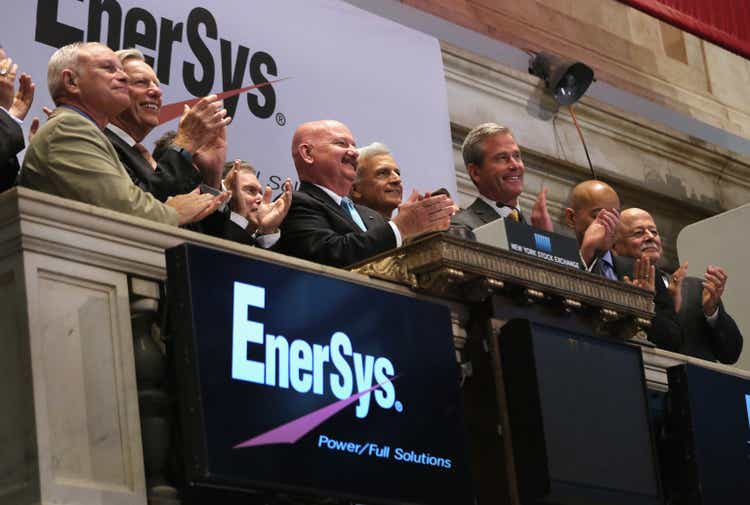John Moore
Investment Thesis
EnerSys (NYSE:ENS) is an industrial solutions firm with a heavy focus on stored energy. ENS has the largest market share in the world, with 22% of global stored energy for industrial applications being on ENS equipment.
While most media coverage on electrification of the economy has heavily favored SPACs and EVs, ENS has been powering the industrial transformation and expanding rapidly. Every segment has seen a record backlog (total backlog of $1.3 billion), with an estimated $5 billion being added to the total addressable market in FY23.
Through dividends and extensive buybacks, ENS returned $186 million to shareholders in FY22. Though headwinds remain significant in the supply chain, price increases have outpaced input costs for ENS, realizing an 11.5% increase (record-breaking $907 million) in revenue during 1Q23. We believe that once headwinds subside, ENS will be able to realize sustained revenue increases and increase its share price.
|
EnerSys |
E2023 |
E2025 |
E2026 |
|
Price-to-Sales |
0.7 |
0.7 |
0.6 |
|
Price-to-Earnings |
13.1 |
10.3 |
8.5 |
|
EV/EBITDA |
9.7 |
8.4 |
7.4 |
Products and Divisions
ENS primarily focuses on business-to-business (B2B) markets.
|
Segment |
FY22 Sales ($ millions) |
Sales Increase (year over year) |
Adjusted Operating Margin |
|
Energy Systems |
$1,537 |
+ 11% |
3.1% |
|
Motive Power |
$1,361 |
+ 17% |
12.5% |
|
Specialty |
$459 |
+ 6% |
9.9% |
Energy systems makes up the largest portion of sales but has the lowest margin of the segments. The segment is primarily focused on telecommunications, uninterrupted power supplies, and utility applications. 5G and the California Public Utilities Commission (CPUC) have both proven to be the biggest growth drivers for the segment. However, despite a record high $850 million backlog (up 113% year over year in 1Q23), there are significant headwinds regarding the supply chain and historically high price increases for inputs.
However, ENS does believe that fast-charging orders for electric vehicle (EV) charging are back on track to be delivered by the end of FY23. Tying together ENS systems is the proprietary Enersys Operating System (EOS). Among end-clients, increased adoption of EOS would significantly reduce installation costs and potentially increase sales volume in the long term.
Motive power has seen strides in recent years, with ENS focusing primarily on small-vehicle and commercial vehicle batteries. Most coverage and venture capital money have flowed toward EVs and SPACs, allowing ENS to quietly gain a 32% global market share, with >50% domestically in North America. One of the largest innovations in recent years (and what drove the acquisition of NorthStar in FY19) is the thin plate pure lead (TPPL) battery. This battery is significantly different from lithium-ion in that it offers a low-maintenance alternative while keeping most of the advantages of fast-charging cells. ENS intends to increase capacity for TPPL manufacturing by $1.5 billion by FY24.
Finally, the specialty projects segment is the proprietary solutions for everything from spacecraft to military applications. The most recent and most publicized of these projects is ENS’s reliable Lithium-ion ABSL product, which was used by Northrop Grumman (NOC) in the James Webb Space Telescope. The ABSL was selected due to its extensive history, with over 300 spacecraft using ABSL batteries.
Growth and Sustainability
The current total addressable market (“TAM”) for ENS is estimated to be $10.4 billion, with $5 billion in new market opportunities potentially increasing TAM to over $16 billion in 2023. As ENS expands into different markets, it is clear that they will play a key role in the low-carbon future given their already dominant market share.
ENS’s product roadmap involves tracking “megatrends” (5G, EVs, IoT) closely. This may include strategically deploying M&A to enter markets where they may not have comparable products, or where synergies would provide significant advantage.
One of the targeted growth drivers for ENS is expanding the margin on products offered through marketing of higher-value products. The strategy hopes to harness the trend for maximum uptime with 5G. Since much of 5G systems relies on millimeter-wave technology, requiring many small cell towers and boosters, there is significant need to ensure that all nodes stay online.
Risk
The primary risk facing ENS is supply chain issues and procurement of inputs. China is the largest supplier of rare-earth metals in the world, with the zero-COVID policy proving to be a detriment for firms globally. While ENS has increased prices faster than the cost of inputs has risen, it could potentially slow adoption significantly if the price of electrification exceeds the perceived benefits.
ENS does expect headwinds to subside into FY23, with the backlog shrinking significantly by the end of the fiscal year.


Be the first to comment